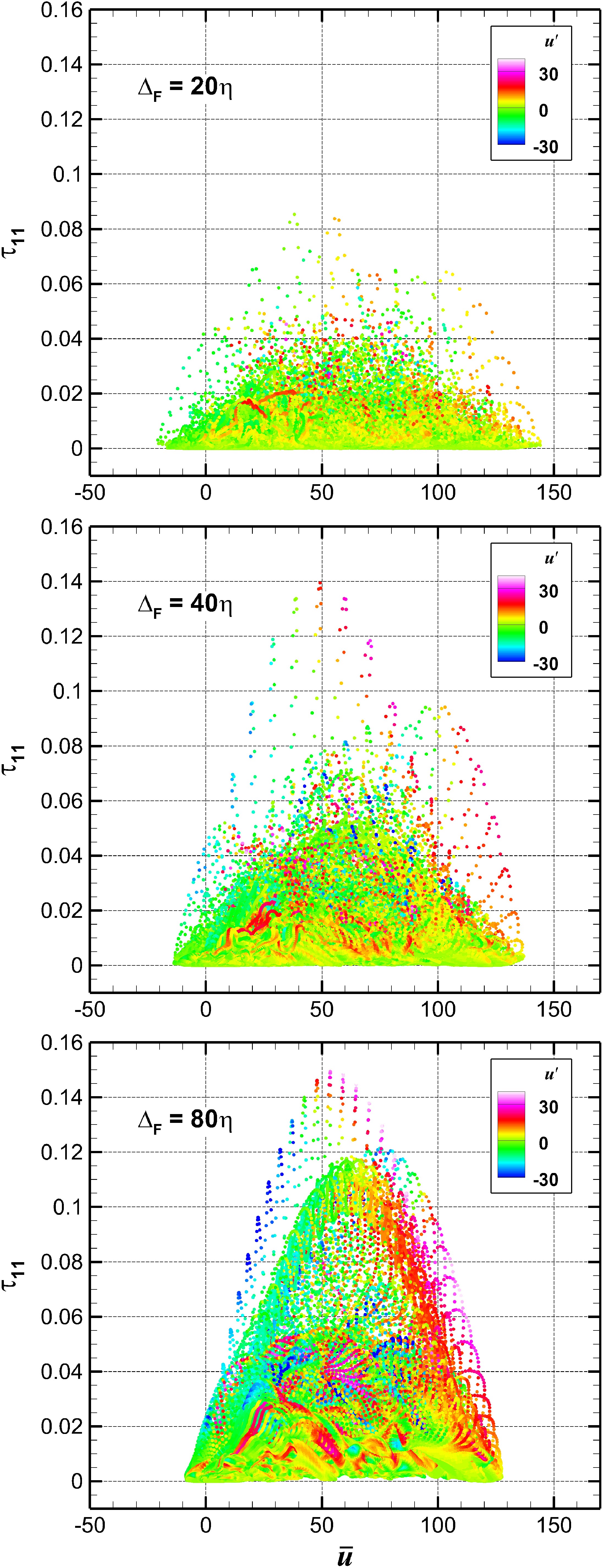SGS Stress Transport Equation-based SGS Modeling for Comprehensive LES Model
JAXA Supercomputer System Annual Report April 2020-March 2021
Report Number: R20ECMP08
Subject Category: Competitive Funding
- Responsible Representative: Shingo Matsuyama, Aeronautical Technology Directorate, Numerical Simulation Research Unit
- Contact Information: Shingo Matsuyama(smatsu@chofu.jaxa.jp)
- Members: Shingo Matsuyama
Abstract
In this study, we aim to realize a comprehensive LES that does not require any tuning for model parameters to the target flow field by solving the SGS stress transport equations. The SGS stress equations are derived exactly from the spatial filtering operation, but requires modeling for the unclosed terms contained in the equations. Therefore, in this study, the unclosed terms are modeled by a priori test using a DNS database of turbulent plane jet, and we try to establish a new LES model with SGS stress transport equations.
Reference URL
Please refer to https://kaken.nii.ac.jp/en/grant/KAKENHI-PROJECT-18K03963/ .
Reasons and benefits of using JAXA Supercomputer System
In order to model the unclosed terms in the SGS stress transport equations, a priori test using statistical data by DNS is required for high Reynolds number condition. For performing DNS under high Reynolds number condition of Re > 10000, a numerical mesh of the order of one billion points is required. Such large-scale simulation can be executed only on a supercomputer, and therefore, supercomputer system is indispensable for carrying out this research.
Achievements of the Year
The SGS stress transport equation type LES model developed in the last year can evaluate the SGS stress with high accuracy, but it cannot evaluate the SGS velocity component itself. Since it is expected that the GS velocity component alone will not give good results when LES is performed on a coarse grid, we have worked on a method to evaluate the SGS velocity component in this year. The correlation of the GS velocity component and the SGS stress with the SGS velocity component was analyzed by a priori tests using the DNS database (Figures 1 and 2). The correlation was evaluated for the instantaneous flowfield, and the results (Fig. 3) did not reveal a simple correlation. We would like to conduct analysis using more advanced methods such as machine learning in the future.

Fig.1: Instantaneous contours of streamwise velocity u and filtered data on the x-y plane (z = 0) from the DNS at Re = 104

Fig.2: Instantaneous contours of SGS stress (

Fig.3: Correlation of the GS velocity component and the SGS stress with the SGS velocity component by scatter plots for u and
Publications
- Non peer-reviewed papers
1) Shingo Matsuyama, "OK, LES. Tell Me the Answer for Turbulent Planar Jet", Proceedings of Fluid Dynamics Conference / Aerospace Numerical Simulation Symposium 2020 Online, 2020.
2) Shingo Matsuyama, "LES Modeling Using a Transport Equation of SGS Stress Tensor", Proceedings of the 34th CFD Sympoium, A02-3, 2020.
3) Shingo Matsuyama, "LES Modeling Using a Transport Equation of SGS Stress Tensor", Proceedings of the 36th TSFD Sympoium, 2021.
- Oral Presentations
1) Shingo Matsuyama, "OK, LES. Tell Me the Answer for Turbulent Planar Jet", Fluid Dynamics Conference / Aerospace Numerical Simulation Symposium 2020 Online, 2020.
2) Shingo Matsuyama, "LES Modeling Using a Transport Equation of SGS Stress Tensor", the 34th CFD Sympoium, A02-3, 2020.
3) Shingo Matsuyama, "LES Modeling Using a Transport Equation of SGS Stress Tensor", the 36th TSFD Sympoium, 2021.
Usage of JSS
Computational Information
- Process Parallelization Methods: MPI
- Thread Parallelization Methods: OpenMP
- Number of Processes: 750 - 1500
- Elapsed Time per Case: 100 Hour(s)
Resources Used(JSS2)
Fraction of Usage in Total Resources*1(%): 0.10
Details
Please refer to System Configuration of JSS2 for the system configuration and major specifications of JSS2.
| System Name | Amount of Core Time(core x hours) | Fraction of Usage*2(%) |
|---|---|---|
| SORA-MA | 596,064.44 | 0.11 |
| SORA-PP | 0.00 | 0.00 |
| SORA-LM | 44.56 | 0.03 |
| SORA-TPP | 0.00 | 0.00 |
| File System Name | Storage Assigned(GiB) | Fraction of Usage*2(%) |
|---|---|---|
| /home | 342.25 | 0.31 |
| /data | 1,628.02 | 0.03 |
| /ltmp | 279.02 | 0.02 |
| Archiver Name | Storage Used(TiB) | Fraction of Usage*2(%) |
|---|---|---|
| J-SPACE | 0.00 | 0.00 |
*1: Fraction of Usage in Total Resources: Weighted average of three resource types (Computing, File System, and Archiver).
*2: Fraction of Usage:Percentage of usage relative to each resource used in one year.
Resources Used(JSS3)
Fraction of Usage in Total Resources*1(%): 2.28
Details
Please refer to System Configuration of JSS3 for the system configuration and major specifications of JSS3.
| System Name | Amount of Core Time(core x hours) | Fraction of Usage*2(%) |
|---|---|---|
| TOKI-SORA | 12,565,200.36 | 2.70 |
| TOKI-RURI | 0.00 | 0.00 |
| TOKI-TRURI | 0.00 | 0.00 |
| File System Name | Storage Assigned(GiB) | Fraction of Usage*2(%) |
|---|---|---|
| /home | 342.25 | 0.23 |
| /data | 1,628.02 | 0.03 |
| /ssd | 13.62 | 0.01 |
| Archiver Name | Storage Used(TiB) | Fraction of Usage*2(%) |
|---|---|---|
| J-SPACE | 0.00 | 0.00 |
*1: Fraction of Usage in Total Resources: Weighted average of three resource types (Computing, File System, and Archiver).
*2: Fraction of Usage:Percentage of usage relative to each resource used in one year.
JAXA Supercomputer System Annual Report April 2020-March 2021


